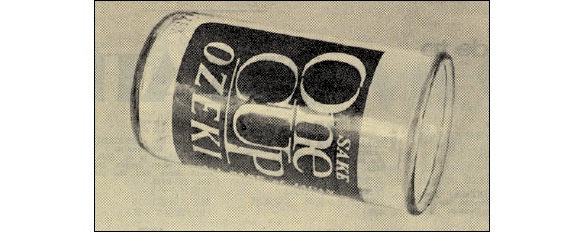Having always spent a disproportionate amount of our leisure time in a dedicated pursuit of the pleasures of the grape, we have watched with interest and have joined on no few occasions in the ceremonial exchange of the sakazuki. Lest we confuse the issue, the sakazuki is the tiny porcelain cup that is generally used by the Japanese when drinking that fabled nectar of the Orient— sake.
Learn your lesson well, and during your stay in Japan when you find yourself as the guest of honor at a formal Japanese dinner, or hanging over the bar in some tiny little hideaway, you will be well on your way to becoming not only the lion but the very life of the party.
At a time of his own choosing in the course of a Japanese style dinner, your host will invariably settle himself before you on the tatami-matted floor and you will know that the moment of truth has arrived. Right here is where your ability to handle the sakazuki (not to mention its contents) comes into its own, and here is how the game is played.
First, toss off whatever sake you may have in your cup immediately. Then, holding it casually between thumb and forefinger (the gracefully extended little finger is also a nice touch here) dip the cup into the rinsing bowl which will be right there in the middle of the table. Now shake the cup over the rinsing bowl once or twice to get rid of any stray drops of water and then offer it (the cup) to your host. With us? Good.
Your next move is to get a firm hold on the nearest bottle of sake (the little sake bottles are called tokkuri and they too will be right there on the table in front of you) and pour your host’s cup full (Note: If in the process of picking up the tokkuri it should burn your fingers put it down quickly and grasp it again with thumb and forefinger as close to the top as possible. Do not put your fingers in your mouth but grab the tip of your ear and cover the awkward moment with some smilingly appropriate remark like, “Kee-rist that’s hot,” and get on with the game.)
The host will raise his cup in thanks and at that very instant you must toast him with the magic word Kampai! which is the Japanese equivalent of cheers, bottoms up, skoal or what have you. Then, after tossing off the drink you so kindly gave him, your host will in turn rinse the cup, give it back to you, fill it and, finally, urge you on with his own heartfelt Kampai! This, of course, is the signal for you to knock back your drink, and the score stands at one all.
At this point in the proceedings you are very definitely in the driver’s seat and in a splendid position to control the action. You can either terminate the whole affair right then and there by simply putting down your cup, or, you can rinse it out, offer it to your host and keep the exchange going indefinitely.
As tempting as this may at first appear, bear in mind that your host will no doubt have several of his associates at the party and you are required to exchange sakazuki with every one of them.
With the law of permutations and combinations being what it is, you will obviously be playing a losing game if you plunge ahead with your host unless you have either an extraordinary capacity, or unless you have a lot of your own associates with you to take up the slack. Did we say losing game? Well, not really, as it is considered highly complimentary to your host if you get smashed during the course of the dinner, just as the exchange of sakazuki is in itself a great and traditional compliment and the more the merrier.
First and foremost, the exchange of sakazuki (which rhymes with sock-a-zoo-key) is a recognition of friendship among equals. It is also—in the spirit of noblesse oblige—a traditional recognition of services rendered by anyone of inferior rank (Carrying on with my secretary? Why, my dear, we were simply exchanging sakazuki. Wonderful worker, that child). By the same token, it is also the custom for old friends to exchange sakazuki at any time anywhere as a reaffirmation of friendship.
As you gaze over your sakazuki some night into a pair of warm, dark and altogether inviting almond eyes, it would be well to remember that most marriages in Japan are solemnized by a ceremonial exchange of sakazuki that holds as much meaning for the Japanese as the traditional exchange of rings in the western world. Temperance is the order of the day at a Japanese wedding, however, and the bride and groom are limited to only three small sips. This, of course, is during the ceremony and has no bearing on what goes on when the knot is finally tied.
Sake, which is pronounced “sock Kay,” comes in a number of different grades ranging from a popskull called shochu all the way up to a “special” grade known as tokkyu. Tokkyu sake served well-chilled is surprisingly good and can be favorably compared with the light dry wines of the Rhine Valley or even with a good Chablis. (Saki, by the way, was an English author named Hector Hugh Munro and if he took his nom de plume from Japan, he was a bit off base).
Here are the different grades, for ready reference:
Special grade—tokkyu
First grade—ikkyu
Second grade—nikyu
Third grade—sankyu
Popskull—shochu
Most sake runs about 17% of alcohol which makes it just a little stronger than champagne and a bit weaker than the average sherry. Most Japanese medical men believe that the custom of warming sake eliminates any harmful effects it might have, and they frown on it being served cold.
There are over 4,000 sake distillers in Japan and each one produces and markets its own brand. A few name brands have attained nation-wide distribution but most sake is sold in the same area in which it is produced.
Although sake is almost invariably referred to as a “wine,” it’s a whole lot more than the simple squeezings from a couple of tubs of rice, and smiling young girls with bare and practical peasant feet play no part in the process. Here, briefly, is how it’s made.
A special type of rice with larger, softer and heavier grains than the usual type eaten in the home is first washed thoroughly and steamed in a large vat. A yeast-like brewing mold is then introduced and the rice is permitted to ferment for approximately four days, but, like good soup, it is stirred frequently. At the end of this time the mold is washed out, fresh water is added and the mixture is again allowed to ferment for another four days. Something called rice malt is then added and the fermentation process continues for three or four weeks. The resulting thick and rather unpleasant looking mess is then put through a filter and the clear liquid that results is allowed to age for still another six or eight weeks. After this aging it is heated to some 60°C (which is about 140° Fahrenheit), seated into huge vats and allowed to cool gradually. Voila, as they say in la belle France, sake.
Sake is inextricably bound up in the Japanese way of life and there are thousands of customs and superstitions associated with it. For example, if you should go fishing here in Japan and should happen to catch a sea turtle, bring him aboard, break out the sake and let the old boy have his fill. When he indicates that he has had a delicate sufficiency (complete withdrawal is a satisfactory indication that he has reached his limit) drop him back over the side and let him go free. This little kindness will guarantee that your catch of fish for the balance of the day will be the biggest you have ever enjoyed—and, of course, there is nothing in the world to stop you from matching Br’er Turtle cup for cup, so how can you lose?
—W. Somerset Watanabe









